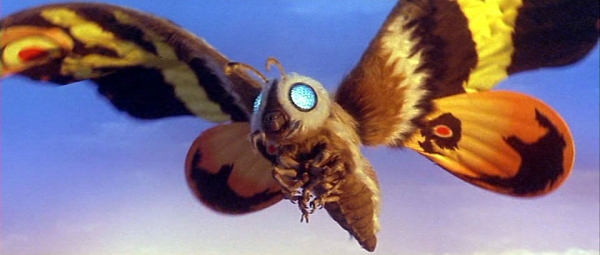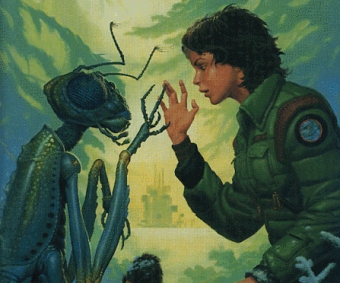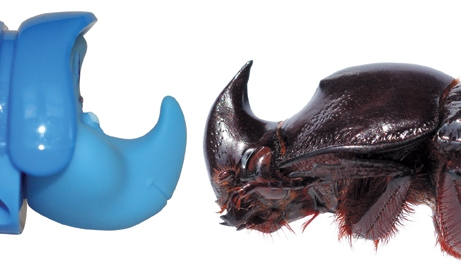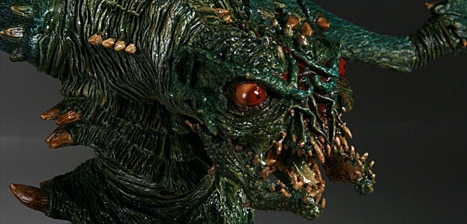| THE TOP TEN HERO BUGS - PART ONE |
| #10 - The Cockroaches of Joe's Apartment |
| #8 - The Heroes of A Bug's Life |
The villain of this computer animated children's film was pushed just slightly off the bad bug list, but the film's
protagonists had a guaranteed spot in this one. It's impossible to pin down any one of them as the most
valiant, so this spot must be shared by a Preying Mentis, Gypsy Moth, (male) Ladybug, Walkingstick,
Caterpillar, Black Widow Spider, Rhinoceros Beetle, two hilarious pillbugs and several hundred ants. When
Flik, the bumbling oddball of the ant colony, ruins their yearly offering to the bullying locusts, he vows to find
bigger, stronger insects to help fight them off. Poor communication instead lands him with a troupe of insect
circus performers, but through their collective talents and genuine compassion for the tiny ants, they emerge
just barely victorious. My personal favorite of the bunch is Manny the Mantis, one of the last great
performances by Jonathan Harris (Dr. Smith of Lost in Space fame) before his death in 2002.
protagonists had a guaranteed spot in this one. It's impossible to pin down any one of them as the most
valiant, so this spot must be shared by a Preying Mentis, Gypsy Moth, (male) Ladybug, Walkingstick,
Caterpillar, Black Widow Spider, Rhinoceros Beetle, two hilarious pillbugs and several hundred ants. When
Flik, the bumbling oddball of the ant colony, ruins their yearly offering to the bullying locusts, he vows to find
bigger, stronger insects to help fight them off. Poor communication instead lands him with a troupe of insect
circus performers, but through their collective talents and genuine compassion for the tiny ants, they emerge
just barely victorious. My personal favorite of the bunch is Manny the Mantis, one of the last great
performances by Jonathan Harris (Dr. Smith of Lost in Space fame) before his death in 2002.
| #9 - Martinfly (The Fly II) |
| #7 - The Thranx (Alan Dean Foster's Commonwealth Novels) |
While these stereotypes have been subverted by more than a few authors, (most spectacularly in Orson Scott
Card's Ender's Game) few examples are more overtly heroic than Alan Dean Foster's benevolent "Thranx,"
introduced in his 1982 novel "Nor Crystal Tears;" a "first contact" account from their perspective. Though we
wear our skeletons on the inside of our squishy, musky, dirt-colored bodies, and though we call to mind their
homeworld's most disease-ridden vermin, these colorful and fragrant arthropods eventually take a real shining
to our warm-blooded people, and come to our aid on an unexpectedly grand scale against a truly horrific
enemy. Ultimately, these two very different species are brought together as virtually unstoppable allies, and
our two cultures are found to be so complementary that they gradually merge into one. Now known as the
"Humanx," this symbiotic partnership traverses the universe, comes to the aid of sentient species in need and
forges a vast collective of united worlds, standing as a symbol to all that no two species are too alien to get
along.
Thranx superficially resemble preying mantises, but belong to their own alien, eight-legged arthropod group.
Originally, they were eusocial, like bees and termites, but modern medical technology allows any female to
bear young and any semblance of a caste system has been long abolished. This transition was not without its
challengers, and a culture war persisted for many generations. Regardless, thranx instinctively treat females,
even our own women, with the utmost respect, and are most comfortable in large crowds, especially
underground.
The discovery of Homo sapiens rocked the Thranx's understanding of biology, which had long thought it
impossible for a vertebrate to achieve such size without its soft body collapsing off its bones. This is a reversal
of our own scientific laws against large insects.
IN THE REAL WORLD: there aren't any!
Card's Ender's Game) few examples are more overtly heroic than Alan Dean Foster's benevolent "Thranx,"
introduced in his 1982 novel "Nor Crystal Tears;" a "first contact" account from their perspective. Though we
wear our skeletons on the inside of our squishy, musky, dirt-colored bodies, and though we call to mind their
homeworld's most disease-ridden vermin, these colorful and fragrant arthropods eventually take a real shining
to our warm-blooded people, and come to our aid on an unexpectedly grand scale against a truly horrific
enemy. Ultimately, these two very different species are brought together as virtually unstoppable allies, and
our two cultures are found to be so complementary that they gradually merge into one. Now known as the
"Humanx," this symbiotic partnership traverses the universe, comes to the aid of sentient species in need and
forges a vast collective of united worlds, standing as a symbol to all that no two species are too alien to get
along.
Thranx superficially resemble preying mantises, but belong to their own alien, eight-legged arthropod group.
Originally, they were eusocial, like bees and termites, but modern medical technology allows any female to
bear young and any semblance of a caste system has been long abolished. This transition was not without its
challengers, and a culture war persisted for many generations. Regardless, thranx instinctively treat females,
even our own women, with the utmost respect, and are most comfortable in large crowds, especially
underground.
The discovery of Homo sapiens rocked the Thranx's understanding of biology, which had long thought it
impossible for a vertebrate to achieve such size without its soft body collapsing off its bones. This is a reversal
of our own scientific laws against large insects.
IN THE REAL WORLD: there aren't any!
| #6 - Mothra (Toho giant monster films) |
Part of Toho Studio's world famous roster of giant, city-wrecking monsters, Mothra made her grand entrance in
a 1961 film of the same name, in which the capture of two tiny, psychic fairies (don't ask) provokes the wrath of
their protector, a caterpillar capable of knocking over skyscrapers. After pupating into her adult form, Mothra
uses powerful gusts of wind to wreak havoc on mankind until the fairies are set free and peace can be
restored.
a 1961 film of the same name, in which the capture of two tiny, psychic fairies (don't ask) provokes the wrath of
their protector, a caterpillar capable of knocking over skyscrapers. After pupating into her adult form, Mothra
uses powerful gusts of wind to wreak havoc on mankind until the fairies are set free and peace can be
restored.
Mothra would return on numerous occasions to co-star with the king of the monsters himself, Godzilla,
becoming one of his most frequent allies and enemies for over a dozen separate films. Whatever her
relationship with the green giant, Mothra is generally portrayed as a highly intelligent, even angelic protector of
the planet Earth, doling out divine justice to invading aliens, corrupt humans and rampaging monsters alike. In
the rare event that Mothra is fatally defeated, a new caterpillar - sometimes even several - will hatch as if by
magic to avenge their fallen mother and eventually take her place.
IN THE REAL WORLD: Mothra's caterpillars are directly patterned after those of the silk moth, one of the
world's only true domesticated insects. These "silkworms" have been bred in captivity for so long that they
cannot reach maturity without human assistance, instinctively "beg" human hands for food and no longer fly as
adults.
becoming one of his most frequent allies and enemies for over a dozen separate films. Whatever her
relationship with the green giant, Mothra is generally portrayed as a highly intelligent, even angelic protector of
the planet Earth, doling out divine justice to invading aliens, corrupt humans and rampaging monsters alike. In
the rare event that Mothra is fatally defeated, a new caterpillar - sometimes even several - will hatch as if by
magic to avenge their fallen mother and eventually take her place.
IN THE REAL WORLD: Mothra's caterpillars are directly patterned after those of the silk moth, one of the
world's only true domesticated insects. These "silkworms" have been bred in captivity for so long that they
cannot reach maturity without human assistance, instinctively "beg" human hands for food and no longer fly as
adults.


| GODZILLA: "They look NOTHING like me!" |
Though a sequel to a remake of an adaptation of a short story, The Fly II is a surprisingly solid piece of cinema
on its own merits. In the previous film, scientist Seth Brundle tests his own matter teleportation system only to
be fused on the genetic level with a stowaway insect. Shortly after this mishap but before his transformation
into gnarled mutant, Brundle turns out to have conceived a perfectly normal looking son...who happens to be a
genius and grows at an extremely accelerated rate. Having lost his mother during birth, the orphaned Martin
Brundle grows up practically a prisoner in a laboratory, carefully monitored by his father's greedy sleazeball of
an ex-boss, Anton Bartok, who maintains a cruel charade of paternal love for his half-human specimen.
Reaching adulthood in only a couple years, Martin unravels the sinister secrets of his foster family just as he
begins his mutation into a powerful, predatory insectoid.
Though he stalks, mutilates and melts people's faces off with corrosive vomit, Martin knows exactly what he's
doing in fly-form as he hunts down and punishes the corporate scumbugs who used him (and his dog, in a
sequence I would rather not spoil) as an unwilling guinea pig.
IN THE REAL WORLD: though an adult housefly can carry large concentrations of bacteria on its hairy feet,
flies and their hungry larvae (maggots) are our greatest line of defense against hazardous organic waste,
clearing away corpses and even less savory refuse before it can become a breeding ground for deadly
pathogens.
on its own merits. In the previous film, scientist Seth Brundle tests his own matter teleportation system only to
be fused on the genetic level with a stowaway insect. Shortly after this mishap but before his transformation
into gnarled mutant, Brundle turns out to have conceived a perfectly normal looking son...who happens to be a
genius and grows at an extremely accelerated rate. Having lost his mother during birth, the orphaned Martin
Brundle grows up practically a prisoner in a laboratory, carefully monitored by his father's greedy sleazeball of
an ex-boss, Anton Bartok, who maintains a cruel charade of paternal love for his half-human specimen.
Reaching adulthood in only a couple years, Martin unravels the sinister secrets of his foster family just as he
begins his mutation into a powerful, predatory insectoid.
Though he stalks, mutilates and melts people's faces off with corrosive vomit, Martin knows exactly what he's
doing in fly-form as he hunts down and punishes the corporate scumbugs who used him (and his dog, in a
sequence I would rather not spoil) as an unwilling guinea pig.
IN THE REAL WORLD: though an adult housefly can carry large concentrations of bacteria on its hairy feet,
flies and their hungry larvae (maggots) are our greatest line of defense against hazardous organic waste,
clearing away corpses and even less savory refuse before it can become a breeding ground for deadly
pathogens.

Intelligent, insect-like alien beings have always been a common trope of science fiction literature, but such
creatures are most commonly written as objects of revulsion; emotionless, instinct-driven galactic conquerers,
murderous flesh-eating parasites or both. They know no compassion, no love and no imagination, wanting
nothing more than to feed, reproduce and expand their territory by any means necessary.
creatures are most commonly written as objects of revulsion; emotionless, instinct-driven galactic conquerers,
murderous flesh-eating parasites or both. They know no compassion, no love and no imagination, wanting
nothing more than to feed, reproduce and expand their territory by any means necessary.


IN THE REAL WORLD: the character "Dim" was designed as a heavily stylized, imaginary variety of rhinoceros
beetle, but a strikingly similar real-world species would be discovered eight years after the film's release. At the
time of this writing, Megaceras briansaltini is known from only a single specimen.
beetle, but a strikingly similar real-world species would be discovered eight years after the film's release. At the
time of this writing, Megaceras briansaltini is known from only a single specimen.

Being an advocate of all things with their skeletons on the outside, I couldn't very well do a list of culture's most
villainous bugs without offering a positive contrast. For every insect that bites, stings or harbors infectious
microbes, there are at least several hundred more with no capacity to pester us at all, and as the majority of all
animal life, insects and arachnids are the very heart of the world's terrestrial ecosystems. Were they to vanish
overnight, most other lifeforms would be doomed to extinction; but the beetles, roaches and ants of the world
could get along just find without the likes of us.
Fortunately, popular culture does occasionally take a break from mutant spider-demons to portray exoskeletal
beings in a more benevolent light...
villainous bugs without offering a positive contrast. For every insect that bites, stings or harbors infectious
microbes, there are at least several hundred more with no capacity to pester us at all, and as the majority of all
animal life, insects and arachnids are the very heart of the world's terrestrial ecosystems. Were they to vanish
overnight, most other lifeforms would be doomed to extinction; but the beetles, roaches and ants of the world
could get along just find without the likes of us.
Fortunately, popular culture does occasionally take a break from mutant spider-demons to portray exoskeletal
beings in a more benevolent light...

The first full-length motion picture ever produced by MTV, Joe's Apartment was expanded from a short sketch
that used to air during the network's commercial breaks. When the titular Joe moves to the slums of New York
City, the cockroaches of his run-down apartment take such a shining to his slovenly, apathetic lifestyle that
they reveal to him their biggest secret; not only can they talk, but they can sing!
This low-budget, corny and crude musical adventure may not offer much in the way of depth, but if you happen
to like cockroaches - and I certainly do - you'll be hard-pressed to find them in a more positive role. Their
over-eager friendship with Joe nearly ruins his life and there's even a point at which they're plotting his murder,
but in the end, they set everything right (several times over) and show just how much valor can be packed into
several thousand tiny bugs.
Oh, and they sing beautifully.
IN THE REAL WORLD: though now regarded as "pests," the same cockroaches that live in our houses were
beneficial to our ancestors as a natural clean-up crew, eating mold, mildew and nastier little parasites.
that used to air during the network's commercial breaks. When the titular Joe moves to the slums of New York
City, the cockroaches of his run-down apartment take such a shining to his slovenly, apathetic lifestyle that
they reveal to him their biggest secret; not only can they talk, but they can sing!
This low-budget, corny and crude musical adventure may not offer much in the way of depth, but if you happen
to like cockroaches - and I certainly do - you'll be hard-pressed to find them in a more positive role. Their
over-eager friendship with Joe nearly ruins his life and there's even a point at which they're plotting his murder,
but in the end, they set everything right (several times over) and show just how much valor can be packed into
several thousand tiny bugs.
Oh, and they sing beautifully.
IN THE REAL WORLD: though now regarded as "pests," the same cockroaches that live in our houses were
beneficial to our ancestors as a natural clean-up crew, eating mold, mildew and nastier little parasites.